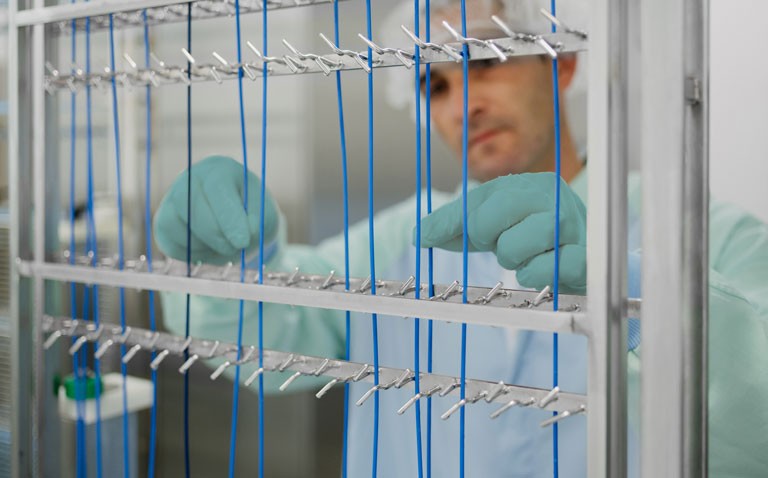This website is intended for healthcare professionals only.
Take a look at a selection of our recent media coverage:
2nd December 2021
Despite being the most harmful type of battery when swallowed by children,1 and an increasing number of cases being reported worldwide,2,3 due to the wide abundance of button batteries in consumer electronics, BBI remains an issue too few people understand or are aware of.
BBs are used to power many household items including toys, gadgets, watches, medical devices (hearing aids, thermometers, glucometers), small appliances (key fobs, remote controls) and many other electronic devices. The Child Accident Prevent Trust (CAPT) have provided useful guidance on where button batteries can be found. BB are accessible throughout their lifecycle; including when purchased new, from appliances, and at the end of life. A study has shown that in around 60% of cases, batteries are directly taken from an electrical device by the child itself, while around 30% of the children ingest loose batteries. In approximately 10% of cases, the batteries were obtained from the packaging.4 Currently in Europe, only toys are required to have durable, secure battery compartments.
According to recent data there has been a seven-fold increase in the relative risk of severe morbidity due to BBI in the last two decades.5 Of all children worldwide presenting with foreign body ingestion, the percentage of children with battery ingestion is estimated to be as high as 7–25% (approximately).6–9 Most BBI cases occur in children below 6 years of age, with a peak at 1 year of age, which is also when the highest risk of complications occurs.2,10 Worryingly, research from Great Ormond Street Hospital revealed that BBI in children rose significantly during the lockdown period in the UK.11
Dangers and impact
The tragic case of Harper-Lee Fanthorpe, who died from BBI at the age of just 2 in May 2021 has served as a reminder of the devastating impact BBI can have. The small, shiny surface and round shape of BBs make them both appealing and easy to swallow, particularly for young children. Once consumed, BBs can trigger a chemical reaction that results in a penetrating burn. Importantly, problems caused by BBs are not usually due to chemicals leaking from the battery but driven by the battery itself reacting with bodily fluids, such as mucus or saliva. This creates a circuit that releases a strong alkali that can burn through the throat or stomach and potentially cause further damage to other internal organs.
BBs are particularly dangerous when stuck in the oesophagus, and studies have shown that 12.6% of children who ingested a 20-mm BB suffered severe or fatal injuries.12 This danger is compounded by the fact that BBI diagnosis is particularly challenging, as many ingestions go unwitnessed by parents or carers, and children (depending on age) may not be able to say what has happened. Furthermore, in contrast to the devastating burn occurring inside, the symptoms of ingestion are variable and non-specific, mimic other common childhood illnesses and evolve over the period that the battery is located in the oesophagus. These factors can often lead to delayed diagnosis. Subsequently including battery ingestion in the diagnosis of unexplained symptoms is paramount to avoid unnecessary delay and increasing the risk of severe complications and death.
To effectively treat and manage BBI, early recognition is critical due to the extremely narrow 2-hour time window for removal of batteries impacted in the oesophagus. ESPGHAN has recently published a clinical paper on BBI, developed by its Button Battery Task Force, which includes a medical algorithm providing clinicians with a step-by-step guide on the treatment pathways for BBI.13
Solutions and action
Perhaps the most pressing BBI matter to address is prevention and the urgent need for solutions and action. There are four core elements on this which are set out here: improving public awareness, increasing HCP understanding, BB product design and innovation, and driving policy.
Public awareness
Improving awareness of BBI among parents, carers and the general public, and educating them on how to mitigate the risks of it happening is a key step forward. This will help increase cautiousness when it comes to products containing button batteries or properly disposing of old batteries, but above all it will help push them towards seeking early medical attention when they suspect an ingestion may have taken place. Increasing public awareness will be challenging, not least because it will require the involvement of industry, media, schools, and the Government in addition to medical professionals. However, ESPGHAN is already helping lead the way with this process, developing a short guide for parents, and there are plans for additional resources to be published next year. The European Portable Battery Association (EPBA) has also produced a helpful video for parents regarding safe use of button batteries.
HCP understanding
Currently, clinical understanding and process is not geared towards early diagnosis of BBI in children, as many in the medical community are not well informed. It is vitally important that medical professionals are able to identify a button battery impacted within the oesophagus and are aware of the diagnostic and management approach when a child presents with a battery ingestion. This includes considering BBI as a potential diagnosis, particularly for unexplained symptoms, and ensuring all healthcare professionals are equipped with the knowledge and guidance to address BBI appropriately. This could be achieved by giving more attention to this subject in medical school, post-graduate paediatric, emergency and family medicine training. Furthermore, resources need to be developed by experts and distributed to the medical community. ESPGHAN has recently finalised a short, visual and easy-to-use clinical advice guide on BBI. Collaboration amongst clinical networks is also required to develop and promote strategies for recognising unwitnessed cases, expediting care and managing complications in centres with specific expertise in button battery injury.
BB product innovation
Mitigating the risk of BBI injury also needs to be driven by battery and product design and innovation. One study has calculated that almost 70% of the ingestions can be prevented with screw-secured compartments and individual blisters for batteries.14 Another solution that has been explored is making the battery less attractive for children and while there is currently limited data of its impact on BBI, bitter coatings have been created and are being developed.15
Collaborating with industry on this issue is critical, and ESPGHAN has been working alongside a coalition of other organisations, including the EPBA, to ensure a clear understanding of the hazards that come with poorly secured products and how we effectively tackle those hazards. Earlier this year, the group joined forces to publish a joint statement that committed to preventing button battery ingestion in children. Additionally, ESPGHAN and its Public Affairs Committee has now formed a task force that regularly meets to review the progress of awareness, prevention and management initiatives.
Policy
Lastly, there is an important overarching role for regulatory agencies and policymakers to play on this issue, through evaluating current legislation and implementing national strategies on improving awareness and the safety of button batteries. Recent legislative developments in Australia16 and in the UK17 have hinted towards kickstarting this process. The Australian regulation, due to come into effect in June 2022, replicates existing requirements in international toy standards and includes the requirement for child resistant button battery packaging alongside durable and secure battery compartments for products powered by button batteries. However, these isolated examples can only go so far, and the situation demands widespread action in Europe and across the Globe.
Conclusion
Ultimately, urgent action on BBI is essential and it is required now. The sudden, devastating and potentially fatal impact BBI can have on children simply cannot be ignored and it is imperative on us all to ensure we protect future generations from this completely unnecessary burden. The reality is that we are at the beginning phase of resolving this problem, however, encouragingly we have the knowledge and tools to help significantly reduce BBI cases. We now need the concerted will to implement these properly at the public, medical, industry and policy level.
References
12th November 2021
The CHMP positive opinion for regdanvimab marks the first time a monoclonal antibody treatment for COVID-19 has received a recommendation for marketing authorisation from the European Medicines Agency (EMA).
The positive CHMP opinion was supported by data from the global Phase III clinical trial in which Celltrion enrolled more than 1315 people to evaluate the efficacy and safety of regdanvimab in 13 countries including the US, Spain, and Romania. Data showed regdanvimab significantly reduced the risk of COVID-19 related hospitalisation or death by 72% for patients at high-risk of progressing to severe COVID-19.
Rolling review of regdanvimab had been initiated by the EMA in February 2021 and the announcement of the CHMP positive opinion for regdanvimab follows the submission of a marketing authorisation application to the EMA seeking approval of regdanvimab in October 2021.
“The primary benefits of monoclonal antibodies are their high specificity and safety – they are highly specific for a single target, so these monoclonal antibodies rarely cause undesirable side effects,” said Oana Sandulescu, MD, PhD, Associate Professor of Infectious Diseases at the Carol Davila University of Medicine and Pharmacy in Romania. “An infusion of an hour of monoclonal antibodies like regdanvimab can ease COVID-19 symptoms and reduce complications in recently diagnosed, non-hospitalised people at high risk, and thus plays an important role in preventing further spread of the virus.”
13th October 2021
A study funded by the charity Breast Cancer Now will explore if talazoparib (Talzenna) could be used to treat people with incurable metastatic breast cancer that has spread to the brain.
There are limited treatment options for people with breast cancer that has spread to the brain and a lot of drugs are unable to reach these tumours because of the brain’s natural protection, meaning new treatment discoveries are urgently needed.
Talazoparib is an existing PARP inhibitor drug which works by preventing cancer cells with altered BRCA genes from repairing their DNA, forcing them to die. Although the drug is licensed for use in certain patients with BRCA mutated, HER2 negative locally advanced or secondary (metastatic) breast cancer, it hasn’t been assessed for use on the NHS
Now, a team led by Professor Leonie Young and Dr Damir Vareslija from RCSI University of Medicine and Health Sciences will investigate if the drug could be used to treat secondary breast cancer in the brain.
Through previous research, which analysed tumour samples donated by people whose breast cancer has spread to the brain, the team established that almost half of the tumours had changes in the way they repair their DNA and this could make these tumours vulnerable to PARP inhibitors like talazoparib.
Using tumours and breast cancer cells donated by patients, researchers will now test in the lab if talazoparib is effective in treating secondary breast cancer in the brain. Through further tests using mice and sophisticated laboratory models mimicking the brain’s protective system, the researchers will see if the drug can also reach tumours in the brain. The researchers aim to identify key features of a tumour that responds to this type of treatment to establish who could benefit most.
The study is being funded by the Breast Cancer Now Catalyst Programme, which aims to accelerate progress in world-class breast cancer research through innovation and collaboration. As part of the Programme, Pfizer have provided Breast Cancer Now with funding through an independent medical research grant and given the charity’s researchers access to several Pfizer medicines.
Professor Leonie Young, Professor in the Department of Surgery at RCSI University of Medicine and Health Sciences said: “Our previous research has shown that, in many cases, secondary breast cancer tumours in the brain have changes in the way they repair their DNA and we believe this could make them vulnerable to PARP inhibitor drugs like talazoparib.
“People are always at the heart of the research we do and we are always trying to answer questions that are important to our patients. The support of Breast Cancer Now will enable us to learn more about the effectiveness of these powerful drugs to hopefully treat people with secondary breast cancer which has spread to the brain in the future.”
Dr Simon Vincent, Director of Research, Support and Influencing at Breast Cancer Now, said: “An estimated 35,000 people in the UK are living with incurable secondary breast cancer, and the fear and uncertainty around when this devastating disease will cut their lives short. We desperately need to discover new ways to treat this incurable disease, including for those whose breast cancer has spread to the brain and who have very limited treatment options.
“That’s why we’re delighted, this Secondary Breast Cancer Awareness Day, to announce that we’re funding Professor Young’s project through The Breast Cancer Now Catalyst Programme. We hope this study will be successful and lead to effective new treatments for those who badly need them.”
5th October 2021
Oesophageal cancer cases have tripled in under 50s over the past 30 years, a study presented at UEG Week Virtual 2021 has found.
The research, conducted in the Netherlands on almost 60,000 patients, found new cases of oesophageal adenocarcinoma had risen from 0.34 to 0.92 per 100,000 population between 1989 and 2018. There was an average increase of 1.5% in males and 3% in females. The dramatic increases were seen in patients under the age of 50 years old with oesophageal adenocarcinoma.
Experts believe that the rise in cases of oesophageal adenocarcinoma reflect changes in lifestyle-related risk factors for the disease, with increases in unhealthy habits including smoking, poor diet and reduced physical exercise.
Ali Al-Kaabi, from Radboud University Medical Centre in Nijmegen, Netherlands, and lead author of the study, explained, “The incidence of oesophageal adenocarcinoma is increasing in young adults. We know the disease is associated with Barrett’s oesophagus, which is a premalignant condition in the lower end of the oesophagus. Gastro-oesophageal reflux (acid reflux), obesity and smoking are also important risk factors for oesophageal adenocarcinoma. We also know that rates of these risk factors have all increased in young adults over the past 30 years.”
Oesophageal cancer is the seventh most common cancer worldwide and it is a highly fatal disease, accounting for 500,000 deaths each year. There are two main subtypes: oesophageal adenocarcinoma, which is linked to obesity and gastro-oesophageal reflux disease, and oesophageal squamous cell carcinoma, which is linked to alcohol and tobacco consumption.
Although patients under the age of 50 were more likely to be diagnosed at an incurable stage compared to those aged 50-74 and over 74 years (47%, 40% and 29% respectively), younger patients were more likely to undergo multimodality treatments and relative survival for the younger age group rose accordingly in comparison to older patients.
Over the study period, the highest survival rates were seen in under 50s with early-stage diseases, with their five-year survival increasing to 99% (+52%). Those who were classed as ‘potentially curable’ had a five-year survival rate of 46% (+22%), whilst incurable or palliative patients had an one-year survival rate of 32% (+11%).
“Relative survival has markedly improved in the younger age group, with a widening survival gap in comparison to older adults”, commented Ali Al-Kaabi. “These differences may reflect the fact that younger patients are more likely to be treated more aggressively with multiple treatments, including chemoradiotherapy followed by surgery, helping either to provide a cure or prolong patient life.
There are many symptoms for oesophageal cancer, but they can often be difficult to spot and confused with other gastrointestinal symptoms. These include having problems swallowing, feeling or being sick, heartburn and indigestion.
“Based on these study findings, it is important that adults under 50 are aware of these oesophageal cancer symptoms to enable earlier diagnosis and a higher chance of survival”, furthered Ali Al-Kaabi. “This is especially important in high-risk groups, including those that smoke, those with obesity, or those that have high levels of alcohol consumption.”
4th October 2021
Gas-related symptoms are associated with poorer quality of life, and higher stress, anxiety, and depression, with breaking wind being the most frequently reported gas issue, affecting eight out of 10 adults in the general population (81.3%) in a 24-hour period.
Other gas-related symptoms included stomach rumbling, which affected 60.5% of respondents, closely followed by belching (58%), and bad breath (48.1%). Trapped wind (47.2%), abdominal distension (39.6%) and bloating/abdominal pressure (38.5%) also had a noticeable impact, while only 11.1% of respondents reported having no gas symptoms. On average, survey participants had been affected by three different gas symptoms within the previous 24-hour period.
The findings from the study, which surveyed nearly 6000 people across the United States, UK, and Mexico, were based on a representative sample of people aged 18 to 99 years asked to fill out validated Intestinal Gas Questionnaires (IGQs) via the internet, to measure the presence and severity of 7 gas-related symptoms in the last 24 hours. Researchers also collected information on body mass index, exercise, emotional wellbeing, and quality of life in the past 7 days.
The survey, conducted by scientists from the Rome Foundation Research Institute in the US in collaboration with Danone Nutricia Research in France, revealed that higher IGQ scores correlated with lower mental health and quality of life scores on the PROMIS Global-10 questionnaire, higher stress, anxiety, and depression, and more non-gastrointestinal (GI) symptoms. However, IGC scores did not correlate with weight/BMI and only had a modest negative association with the amount of exercise taken.
Younger people aged 18 to 34 and 35 to 49 had the highest overall burden of gas-related symptoms, with IGQ total scores of 24 and 22.6 respectively, compared to 12.7 in people aged 50 to 64 and 8.6 in the over 65s. People in Mexico had higher scores for all seven gas symptoms in IGQ questionnaires, and a higher average IGQ total score, of 26 compared to 14.5 in the US and 13.7 in the UK.
Lead author, Professor Olafur Palsson from the University of North Carolina Department of Medicine, said: “I think the most remarkable and surprising finding in our study is that almost all adults in the general population experience some daily gas-related symptoms. This is important given the data also clearly reveals that these symptoms affect people’s general wellbeing. Having a high amount of these common intestinal symptoms is associated with higher levels of depression, anxiety and stress, as well as impaired general quality of life.”
He added, “The reasons for the marked differences in the amount of gas-related symptoms between Mexico and the other countries we surveyed are unknown, and need to be investigated further. Cultural, linguistic, diet or public health factors might affect population levels of gas-related symptoms.”
The survey methods used included the IGQ, the Patient Health Questionnaire non-GI physical symptoms (PHQ-12) and anxiety and depression (PHQ-4) scales, the PROMIS Global-10 QoL questionnaire and questions on exercises amount, height, weight, and life stress.
The research, which was conducted across multiple hospitals in Spain, compared data from the first year of the COVID-19 pandemic with data from the previous year. Of 1385 cases of CRC diagnosed over the two-year period, almost two thirds (868 cases, 62.7%) were diagnosed in the pre-pandemic year from 24,860 colonoscopies. By contrast, only 517 cases (37.3%) were diagnosed during the pandemic, which also saw a 27% drop in the number of colonoscopies performed, to 17,337
Those who were diagnosed with CRC between 15 March 2020 and 28 February 2021 were also older than in the pre-pandemic year, had more frequent symptoms, a greater number of complications and presented at a more advanced disease stage.
Experts say the fall is a consequence of the suspension of screening programmes and the postponement of non-urgent colonoscopy investigations during the pandemic. Fewer cancers were identified by CRC screening in the pandemic period, with just 22 (4.3%) cases found in comparison to 182 (21%) in the pre-pandemic year. During the pandemic, more patients were diagnosed through symptoms (81.2% of diagnoses) compared with the pre-pandemic year (69%).
Dr María José Domper Arnal, from the Service of Digestive Diseases, University Clinic Hospital and the Aragón Health Research Institute (IIS Aragón) in Zaragoza, Spain, and lead author of the study, commented “These are very worrying findings indeed – cases of colorectal cancer undoubtedly went undiagnosed during the pandemic. Not only were there fewer diagnoses, but those diagnosed tended to be at a later stage and suffering from more serious symptoms.”
There was a significant increase in the number of patients being diagnosed with serious complications – a sign of late-stage disease – with an increase in symptoms such as bowel perforation, abscesses, bowel obstruction and bleeding requiring hospital admission. These cases made up 10.6% pre-pandemic and 14.7% during the pandemic. The number of stage IV cancers being diagnosed rose during the pandemic year, with stage IV cases making up 19.9% of cases, in comparison to 15.9% in the previous year.
“Although these figures are across a population of 1.3 million in Spain, it’s highly likely that the same drop in diagnoses would have happened elsewhere across the globe where screening was stopped and surgeries postponed, especially in countries that were heavily impacted by COVID-19”, explained Dr Arnal.
“Colorectal cancer is often curable if it’s caught at an early stage. Our concern is that we’re losing the opportunity to diagnose patients at this early stage, and this will have a knock-on effect on patient outcomes and survival. We are likely to see this fall out for years to come.”
Source
Impact of the COVID-19 pandemic in the diagnosis and characteristics of colorectal cancer patients, presented at UEG Week Virtual 2021
18th June 2021
Scientists have identified a class of targeted cancer drugs that offer the potential to treat patients whose tumours have faulty copies of the BRCA genes.
The drugs, known as POLQ inhibitors, specifically kill cancer cells with mutations in the BRCA genes while leaving healthy cells unharmed.
And crucially, they can kill cancer cells that have become resistant to PARP inhibitors – an existing treatment for patients with BRCA mutations.
Researchers are already planning to test the new drug class in upcoming clinical trials. If the trials are successful, POLQ inhibitors could enter the clinic as a new approach to treating a range of cancers with BRCA mutations, such as breast, ovarian, pancreatic and prostate cancer.
Scientists at The Institute of Cancer Research, London, and the pharmaceutical company Artios, explored the potential of using POLQ inhibitors in treating cancer cells with defects in the BRCA genes.
Their study, published in Nature Communications, was funded by Artios, Cancer Research UK and Breast Cancer Now.
For some time now, scientists have known that genetically removing a protein known as POLQ killed cells with BRCA gene defects, although drugs that prevent POLQ from working had not been identified. In this new work, the researchers identified prototype drugs that not only stop POLQ from working, but which also kill cancer cells with BRCA gene mutations.
Both BRCA genes and POLQ are involved in repairing DNA. Cancer cells can survive without one or other of them, but if both are blocked or their genes switched off, cancer cells can no longer repair their DNA and they die.
Researchers found that when cells were treated with POLQ inhibitors, cancer cells with BRCA gene mutations were stripped of their ability to repair their DNA and died, but normal cells did not. By killing cancer cells with BRCA gene mutations, while leaving normal cells unharmed, POLQ inhibitors could offer a treatment for cancer with relatively few side effects.
Researchers also found that POLQ inhibitors work very well when used together in combination with PARP inhibitors.
The addition of POLQ inhibitors meant that PARP inhibitors were effective when used at a lower dose. And in laboratory tests in rats and in organoids – three-dimensional mini-tumours grown in the lab – POLQ inhibitors were able to shrink BRCA-mutant cancers that had stopped responding to PARP inhibitors because of a defect in a set of genes known as the ‘Shieldins’.
This suggests that POLQ inhibitors could offer an alternative treatment where PARP inhibitors are no longer working. Researchers believe that using a POLQ inhibitor in combination with a PARP inhibitor in patients with cancers that have faulty BRCA genes could prevent resistance from emerging in the first place.
Scientists at The Institute of Cancer Research (ICR), funded by Breast Cancer Now and Cancer Research UK, discovered how to genetically target PARP inhibitors against BRCA-mutant cancers and, with colleagues at The Royal Marsden NHS Foundation Trust, helped run clinical trials leading to the first PARP inhibitor being approved for use.
The next step will now be to test POLQ inhibitors in clinical trials led by Artios.
Study co-leader, Professor Chris Lord, Professor of Cancer Genomics at The Institute of Cancer Research, London, and Deputy Director of the Breast Cancer Now Toby Robins Research Centre at the ICR, said: “All cells have to be able to repair damage to their DNA to stay healthy – otherwise mutations build up and eventually kill them. We have identified a new class of precision medicine that strips cancers of their ability to repair their DNA. This new type of treatment has the potential to be effective against cancers which already have weaknesses in their ability to repair their DNA, through defects in their BRCA genes. And excitingly, the new drugs also seem to work against cancer cells that have stopped responding to an existing treatment called PARP inhibitors – potentially opening up a new way of overcoming drug resistance. I’m very keen to see how they perform in clinical trials.”
Professor Paul Workman, Chief Executive of The Institute of Cancer Research, London, said: “It’s exciting that the new POLQ inhibitors should provide a different approach to treating cancers with BRCA gene defects – and particularly that this class of drugs should retain their activity in cancers that have developed resistance to PARP inhibitors. Most exciting of all is the potential of combining POLQ and PARP inhibitor drugs to prevent the evolution of BRCA-mutant cancers into more aggressive, drug-resistant forms – a major challenge that we see in the clinic.”
Study Co-Leader, Dr Graeme Smith, Chief Scientific Officer at Artios Pharma, Cambridge, said: “These exciting preclinical results provide a clear rationale for future clinical studies with a POLQ inhibitor. At Artios, we are on track to initiate our POLQ clinical programme before the year end to explore POLQ inhibition in the sensitive cancer types that this study has uncovered. Our planned POLQ inhibitor clinical studies will leverage these results, exploring combination treatment with PARP inhibitors and different types of DNA damaging agents.”
Citation
Zatreanu D et al. Polθ inhibitors elicit BRCA-gene synthetic lethality and target PARP inhibitor resistance. Nat Commun 2021;12:3636
25th May 2021
Scientists and clinicians at UCL and Great Ormond Street Hospital studying the effectiveness of CAR T-cell therapies in children with leukaemia, have discovered a small subset of cells that are likely to play a key role in whether the treatment is successful.
Researchers say ‘stem cell memory T-cells’ appear critical in both destroying the cancer at the outset and for long term immune surveillance and exploiting this quality could improve the design and performance of CAR T therapies.
Researchers assessed the cells of patients involved in the CARPALL Phase I Study, which used a new CAR molecule known as CAT-19 developed between UCL Cancer Institute and UCL Great Ormond Street Institute of Child Health, for treatment in children with acute lymphoblastic leukaemia.
The team compared T-cells from patients who still had CAR T-cells detectable in the blood more than two years after their treatment, with individuals who had lost their cells in the one to two months post treatment.
Using a technique called ‘insertion site barcoding’, researchers were able to study the fate of different types of CAR T-cells in patients after they were given.
Corresponding author Professor Persis Amrolia, based at UCL Great Ormond Street Institute of Child Health and Consultant in Bone Marrow Transplant at GOSH, said: “Using this barcoding technique, we were able to see ‘stem cell memory T-cells’ play a central role both during the early anti-leukaemic response and in later immune surveillance, where the body recognises and destroys cancer cells.
“This suggests that this small sub-group of T-cells are critical to the long-term success of the therapy.”
Researchers say, this work indicates that the teams caring for patients could measure the types of CAR T-cells present after some someone has had their anti-leukaemia therapy, to gain an indication of whether they will be able to preserve their CAR T-cells into the future, avoiding relapse.
Professor Amrolia added: “This new insight may help us to improve our CAR T-cell therapy and work out which patients are at a higher risk of relapse and may benefit from a stem cell transplant after CAR T-cell therapy.”
Dr Biasco added: “It was extremely rewarding to see how the application of our new barcoding technology to study CAR T-cells is unveiling such important information about what happens to these cells after they are given to patients. We now plan to expand the technology we established at UCL and validate these findings in larger groups of patients.”
Co-author Dr Martin Pule said: “This research opens up new avenues to improve CAR design and manufacture, improving the performance of CAR T-cell therapy, to achieve a combination of early tumour clearance and long-term protection from relapses in patients with B cell leukaemia.”
29th April 2021
Experts discuss the need for the health care sector to be included in the EU’s move toward a circular economy.
The healthcare industry creates more than double the amount of greenhouse gas emissions than the entire aviation industry. Yet few are holding the sector accountable.
A recent webinar entitled ’Towards a More Circular, Sustainable and Economic Health Care System in Europe’, offered an expert panel of key stakeholders, including representatives of the European Commission, European Parliament, European Committee of Regions, environmentalists, researchers, and industry to assess the health care waste problem, EU efforts to promote a circular economy, and offer a path forward for solutions.
The discussion is timely, as the EU’s Medical Device Regulation can have a profound impact on the way that hospitals across Europe can lower their carbon footprint while simultaneously reducing costs.
The following article includes edited versions of comments made by the authors at the 11 March 2020 webinar. The edits were made with permission of the authors to make the comments more suitable for printed format.

Dorota Napierska, chemicals policy and project officer, Health Care Without Harm Europe:
If the healthcare sector were a country, it would be the fifth largest emitter of global emissions on the planet. The healthcare sector within the European Union is one of the most polluting after the US and China. Evidence shows that more than 70% of emissions are driven by the supply chain, and it is not really such a surprise if we realise how the healthcare is currently dependent on the use of disposables.
The production, use, and disposal of healthcare products is emblematic of the linear economy. Alternatives to counter these unsustainable practices will be shifting more to a circular healthcare economy model built on principles of resource conservation.
A change to more sustainable and very often reusable products and services brings not only environmental, but also significant financial benefits for hospitals, and medical device reprocessing and remanufacturing have proven to play an important role here.
Napierska: The real success and scaling up of reprocessing in the US started with strong regulation and strict guidelines. So, we are incredibly pleased with the adoption of the medical device regulation in Europe as it offers a path for hospitals to access environmentally preferable, more circular and lower cost reprocessed and remanufactured products.
In line with our global strategy, we believe that reprocessing and remanufacturing of medical devices can support hospitals on their way to maximise reuse, minimise waste, and save money. But this obviously needs support from national authorities, who must first make reprocessing and remanufacturing legal and possible.

Anna Schulte, lead researcher of a detailed life cycle analysis study published recently in the journal, Sustainability, Fraunhofer Institute for Environmental Safety, and Energy Technology UMSICHT:
Medical device remanufacturing might be the most promising circular economy strategy for single-use medical devices because they cannot be easily just reused directly by hospitals and cannot simply be recycled.
Our research team proved environmental benefits associated with remanufactured electrophysiology catheters in 13 out of 16 impact categories evaluated. We found hospitals save more than 20% from the use of remanufactured EP devices compared to exclusive use of virgin devices. Global warming emissions were cut in half when using remanufactured catheters compared to the virgin product. For abiotic resource use, a saving of 28.8% was calculated.
Our study provides information for policy and other decision-makers as it shows the transformative potential from linear to circular use of catheters by applying a remanufacturing system. In a fully circular production system, the carbon footprint could be reduced about 34.5% compared to linear production.
If 750,000 electrophysiological catheters are used in Germany every year, for example, complete collection of catheters for remanufacturing would save about 450 tonnes of CO2 equivalents per-year, in contrast to linear manufacturing.
Schulte: A legal obligation to remanufacture medical devices with high remanufacturing potential could be a key to achieving the circular economy and lead to more sustainability in the healthcare system.
Circular value creation is both environmentally and economically beneficial compared to linear value creation. Remanufacturing of single-use medical devices is an excellent example because it has the potential to preserve the product at the highest value, to be circular and reduce environmental impacts compared to virgin production, and to reduce environmental impacts on a systemic level.

Erik Hansson, Deputy Head of Unit of Medical Devices and Health Technology Assessment, DG SANTE (Health and Food Safety), European Commission:
EU Member States may decide to allow reprocessing of single-use devices. If Member States permit reprocessing of single-use devices (SUDs), those devices must, like any other device, comply with the requirements of the EU Medical Device Regulation. Member States can however choose to derogate from these requirements with regard to devices that are reprocessed and used within a health institution provided the reprocessing is performed in accordance with Common Specifications adopted in August 2020.
Compliance with either of the above paths aims at ensuring that the safety and performance of the reprocessed device is equivalent to that of the original device.
Hansson: They could also decide whether they want to introduce even stricter conditions or requirements than what we have in the Common Specifications. So, Member States have a few options to decide what they wish to do with this new legal framework. The Member States have the obligation to notify us whether they will permit reprocessing of single-use devices, and how they want to do so – whether they wish to use the Common Specifications, whether to allow outsourcing to external reprocessors, and so on.
The Common Specifications contain requirements for organisation and risk management, for instance when contracting an external reprocessor; staff, premises, and equipment; monitoring of changes made by manufacturers; determination of the reprocessing process; technical documentation and so forth. The Common specifications also include requirements for the procedures and steps of the reprocessing cycle; the quality management system, annual audits and reporting of incidents; and traceability, for instance, tracking reprocessing cycles and keeping records.
What is the Circular Economy Action Plan, and what else should healthcare entities know about the path toward a more circular economy?

Paola Migliorini, Deputy Head of Unit, DG ENV, the European Commission:
The Circular Economy Action Plan announces a set of initiatives for 2021 to ensure that all products on the EU market, including those used in the health sector, are sustainable by design, so that sustainability becomes the norm. And for that we need a product policy framework.
Many products break down too quickly, or cannot be easily reused, repaired, recycled, remanufactured, or refurbished. In healthcare, many are made for single use only. At least 80% of the products’ environmental impacts are determined at the design phase, so it is especially important to ensure that the design is optimal and allows for refurbishment and remanufacturing. We also need to address false green claims to ensure that there is no confusion when a product can claim to be “green”, and that there are clear lines of information for producers and consumers alike.
Currently there is no comprehensive set of requirements that ensures sustainability and the circularity in products, and we need to clearly act on that.
Under the Circular Economy Action Plan, we also want to take the lead on global efforts towards a circular economy. In February, we launched the Global Alliance on Circular Economy and Resource Efficiency to mobilise partners across the globe towards the development of a circular economy going beyond EU borders.


Sirpa Pietikäinen, Finnish Member of the European Parliament, representing the European People’s Party. She is a member of the Economic and Monetary Affairs Committee and a substitute member of the Environment, and the Public Health and Food Safety (ENVI) Committee:
We would need four planets’ worth of resources by 2050 if we do not make drastic changes. So, the first and most important signal from the EU Parliament is that you need to have the right ambition level.
If you do not remember anything else that I have said, please remember that by 2050, all sectors, including the health sector, would need to produce the same or better welfare, the same or better income for your company, and the same or better quality for the customers and patients than today, but with one-tenth of the resources.
We must do this to stay within planetary boundaries that are absolute and non-negotiable. All products marketed in the EU should be durable, upgradable, reusable, repairable, and then recyclable at the highest level as parts of an equipment or as materials.

Tjisse Stelpstra, Regional Minister, Province of Drenthe NL, Member, European Committee of Regions:
The COVID crisis is very urgent, and we must act on it without hesitation. Those working in healthcare know, maybe better than others, that this crisis is about health, it is about life. Let us hope it is a temporary crisis. There is no doubt that this crisis has had great effects on the world economy, and a recovery from this crisis is needed. But there is also another crisis, and it is also about health, and it is also about life, and that is the climate crisis. Where covid seems like an acute illness, the climate crisis is an insidious disease which more and more manifests itself as acute.
Tjisse: Local and regional authorities have an important role. They can help us to not only build a circular economy, but to intensify a circular society more broadly. I think that is what we need. Let us use this reality as a great opportunity for cooperation. There will also be skepticism and ignorance, and that is why we all – especially governments – have a lot of work to do. We must convince our citizens, our companies, our industries, and our clients about the importance of this transition to a circular economy and show them it is not only making the world better environmentally, but it is also the next step to more welfare.
So, I am an optimist, I am hopeful. COVID has shown us that we are resilient – in no time, we made a change to a digital economy, so I hope that we can in no time make the change to a circular society.

Alan Wain, Chief Operating Officer for NHS Supply Chain Coordination, National Health System, England:
Remanufacturing is quite sophisticated. Most of these devices cannot simply be put through a sterilizer; you have got to take them apart; you have got to reprocess them put them back together and make sure they are clinically safe to use again.
Just to put remanufacturing into context, if we examine our strategy to net-zero carbon emissions, the NHS needs to take out something like 16.5 million tonnes of carbon dioxide equivalent per year just from the supply chains.
One of the biggest contributors [of emissions in the NHS] is down our supply chains, our suppliers’ own carbon footprints, and that that accounts for about 4.5 million tonnes. Of that, 157,000 tonnes could be removed by using remanufactured or reprocessed devices, and another 202,000 tonnes from reused and refurbished devices.
To achieve our objectives, the NHS needs to be working with our strategic suppliers to achieve a major, seismic shift in carbon footprint reduction. We have been working with Vanguard as a strategic supplier, and we are doing a lot of engagement around the NHS for uptake of remanufactured devices.
It starts with the collection of the original device and sending it off to Vanguard’s remanufacturing unit to remanufacture them for reuse by the NHS. The next step is to get a bigger uptake of these devices within the NHS. There is, now, a small amount of uptake, but the ambition is to get to a much larger footprint wherein 40–50% of the devices being used are remanufactured.
Remanufacturing is an important part of our strategy – though it is not the only part of our strategy – and we are looking forward to working with our strategic suppliers to drive down the carbon footprint across the whole NHS.

Dan Vukelich, President and CEO, Association of Medical Device Reprocessors:
The provisions in Article 17 of the MDR represent one of the greatest opportunities for hospitals in Europe to lower costs, reduce waste, and reduce greenhouse gas emissions.
Unfortunately, medical device remanufacturing is currently not available in most EU Member States. So AMDR is urging Member States to act quickly to promote this circular economy solution for health. The practice has grown substantially in many countries. In 2019, our members served over 7600 hospitals and surgical centres worldwide, enabling them to participate in a circular economy for hundreds of types of medical devices labelled for single use.
As confirmed by the science presented, devices that are remanufactured have a substantially lower carbon footprint and use less resources.
Additionally, remanufacturing eliminated nearly 7 million kilos of medical waste from landfills and incinerators. This environmental contribution comes at no extra cost. In fact, medical remanufacturing has enabled healthcare systems to save over 446 million euros in 2019. This will potentially change when the MDR comes into force.
Vukelich: So far, the Netherlands and Belgium have allowed remanufactured products and notified the commission. I expect Germany soon, and I would hope before the May deadline that we are going to have some others that will report favourably towards allowing these products.
So, I hope each of us, from our individual standpoints, will encourage the European Commission and the European Parliament to continue down that path of promoting a circular economy and including healthcare within their scope. As we have learned from Anna Schulte’s research and from the example that Alan Wain and others have brought up, reprocessed and remanufactured medical devices are an immediate solution.
22nd February 2021
The report – ‘Heart Failure: A call to action’ – makes ten recommendations, including an increase in the number of specialist heart failure nurses – from one to four for every 100,000 people – to meet the growing demand from a rising number of heart failure cases.
Current recommendations, originally published in 2002, suggest one heart failure specialist nurse (HFSN) per 100,000 population, a target that is currently met by 84% of heart failure services. There is evidence that services are overstretched however, with only one in three HFSNs managing to see more than 65% of patients within two weeks of discharge. Despite an increased prevalence of heart disease, and considerable advances in therapies, the recommendation has remained unchanged.
The report points to the growing prevalence of heart failure. Before the COVID-19 pandemic, around 200,000 new cases were being diagnosed every year, with over 900,000 people in the UK affected. The report warns that COVID-19 could result in a significant increase in the disease, highlighting concerns that two-thirds of patients with heart failure are not seeking care during the pandemic as well as significant delays in treatment.
Louise Clayton, Advanced Nurse Practitioner and Co-Chair of the Alliance for Heart Failure said, “Early input by heart failure specialists, including nurses, has been shown to improve patient outcomes and reduce mortality. Around eight in ten patients admitted with heart failure are now identified and seen by specialists during their admission, with around half seen by a specialist nurse.
“There is huge variation between hospitals though. In 2018, only six out of ten achieved specialist review rates of over 80%. This postcode lottery for patients must be eradicated.
“The shortage of specialist heart failure nurses was an issue long before the Covid-19 pandemic, but its impact means this needs to be addressed more urgently than ever.”
The Alliance for Heart Failure report’s ten recommendations, which build on those made by the All-Party Parliamentary Group on heart disease in 2016, also include:
The Alliance for Heart Failure report ‘Heart Failure: A call to action’ was published on 22 February 2021.